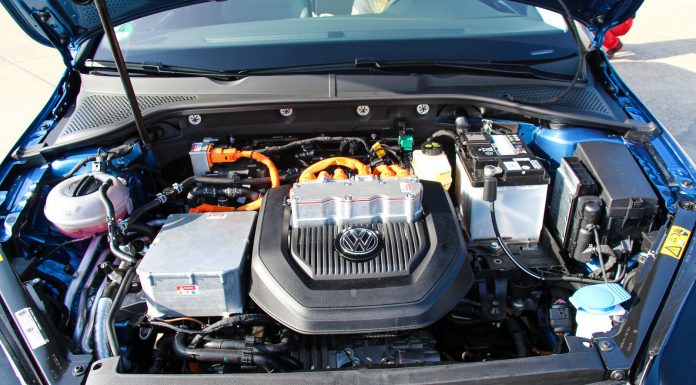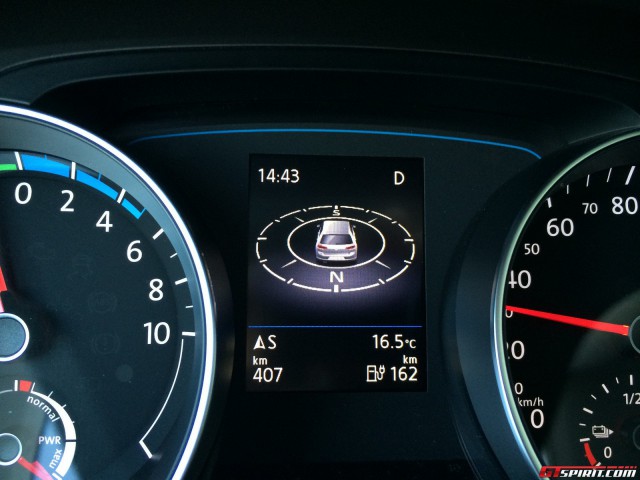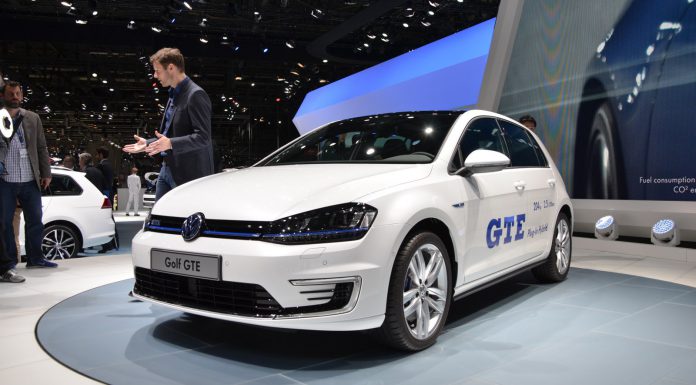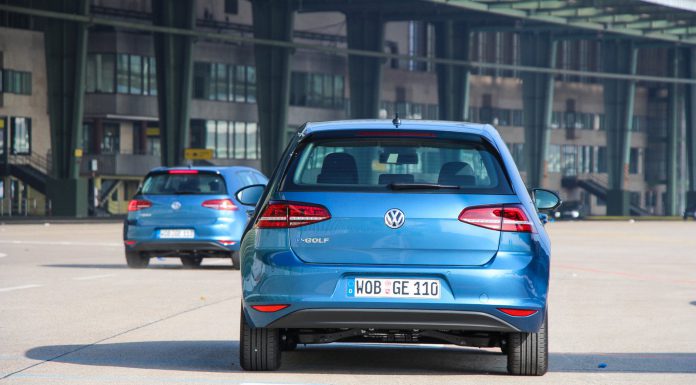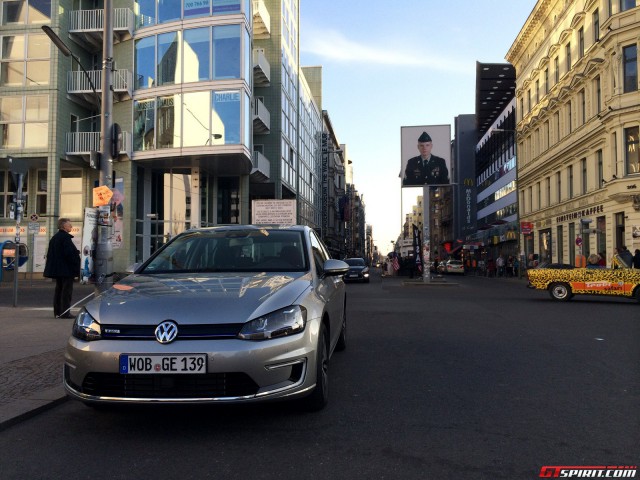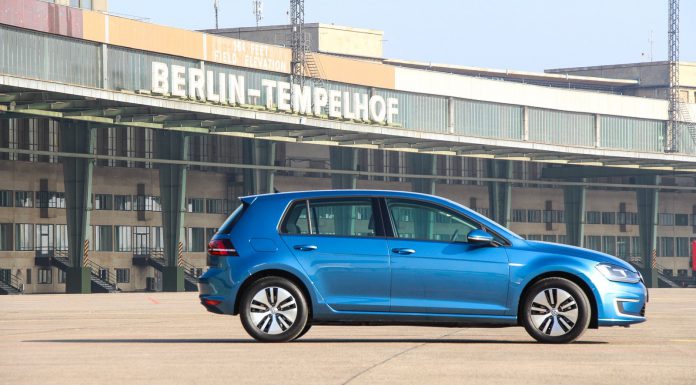The family hatchback market has been dominated for as long as we can remember by one name, the Volkswagen Golf. Those looking for something reliable, affordable, economic and ordinary have always tended to gravitate towards the Golf. The current generation recently added a number of new models to the range, most notably, a performance hybrid and fully electric version. Volkswagen invited us to test the 2015 Volkswagen e-Golf and Golf GTE in the German capital city, Berlin.
It was at the Frankfurt Motor Show 2013 when we first got to see the production-ready Volkswagen e-Golf. The 2015 Volkswagen Golf GTE followed at the Geneva Motor Show 2014 earlier in the month which is when we started to really pay attention. Neither are traditionally our focus here at GTspirit.com, yet the e-Golf and GTE are both interesting technology samples of where the Volkswagen-Audi Group is headed in the next years.
Thanks to its modular baukasten system, the MQB platform for the Golf to be precise, Volkswagen can build all Golf’s regardless of its engine type on the same production line. All MQB cars actually share the same front axle, pedal box and engine positioning, despite varying wheelbase, track and external dimensions. Its not just Volkswagen who uses this Baukasten system, but also Audi and Porsche have developed baukasten that are used throughout the entire group. But before we go into to much detail on the underlying strategy lets take a look at the cars!
2015 Volkswagen e-Golf
To start with the fully electric version, the Volkswagen e-Golf has actually been around for a while, although it is only now that it is ready for a market introduction. It joins the fully electric Volkswagen e-up! and the plug-in hybrid Volkswagen XL1 to become the third Volkswagen model to offer an electronic motor.
In terms of styling, the Volkswagen e-Golf is recognizable for its LED headlights and blue led running lights that run the length of the front facia – a feature that had some people in Berlin look twice at our test car. It also gets distinctive white daytime running lights on the lower front facia which mark the outline of two discreet air intakes. Other than the unique 16-inch alloy Astana wheels, the look is very much conventional Golf.
Obviously, the e-Golf does away with the traditional combustion engine’s exhaust pipes. Inside, the left-side instrument cluster is also very different. It displays the power statistics with the charge, driving range and whether the motor is being charged by the car’s regenerative braking system.
The electric motor is named EEM 85 by Volkswagen. It is built at Volkswagen’s Kessel plant and runs to 12,000 rpm through a single-speed gearbox. The battery is a high-tech 264 cell lithium-ion unit. It is mounted under the front and rear seats and along the central tunnel to help balance the weight. In total, the e-Golf weighs 1,510 kg, of which 318 kg is due to the electric platform. In comparison a Golf TDI Bluemotion weighs in at 1,265 kg, nearly 250 kg less.
One downside to the electronic motor and battery is its susceptibility to cold temperatures. To cure this, Volkswagen fit a heat pump to increase range by 20% during the winter. When the car is not in use or in the event of a crash, the power from the battery is automatically cut off by a battery management controller.
In terms of power delivery, the Volkswagen e-Golf electric motor delivers 85 kW (equivalent to 115 instantaneous horsepower). From a standing start, it develops maximum torque of 270 Nm. Zero to 60 km/h is dealt with swiftly in just 4.2 seconds making it very fast indeed. To 100 km/h, the e-Golf takes just 10.4 seconds and top speed is electronically limited, at 140 km/h. Range is between 130 and and 190 km depending on a number of variables. We would say 140 kilometers is possible without compromise. More would be possible by engaging Eco+ mode which reduces the top speed to 90 km/h, disables the air conditioning and slows throttle responds.
Another consideration to be taken into account with the e-Golf is how you wish to charge it. It comes with a charging cable supplied as standard which allows you to plug it into a 230-volt mains electrical socket. This takes as much as 13 hours from empty to full. To cut this time, Volkswagen can fit a wall box for the garage or carport which finishes the job in just 8 hours. Optionally, a much faster DC current can be specced allowing for an 80 per cent in around 30 minutes – sadly these charging stations are extremely rare in large parts of the world.
2015 Volkswagen Golf GTE
The Volkswagen GTE is a hybrid family hatchback fitted with both a combustion engine and an electronic motor. It is familiar to the Golf GTI and GTD and it has the performance credentials to counteract its economy rhetoric.
Similar to the e-Golf, the front facia features a set of LED headlights with a blue LED line splitting it from the lower facia. The trademark C shape whit LED daytime running lights sit on the lower facia, yet the GTE is distinguished in true Volkswagen style by a subtle badge applied to the grille. The front facia features much larger air intakes, necessary to feed more air into the engine. The side skirts and roof-edge spoiler mirror those applied to the GTI.
The combustion engine is a 1.4-liter turbocharged four cylinder engine with 148 hp to offer. The electric motor offers an additional 101 hp making the combined, total output figure somewhere in the region of 201 hp and 350 Nm of torque. The electric motor has a high-voltage 8.8 kWh liquid-cooled lithium-ion battery – considerably lower than the e-Golf’s 24.2 kWh rating. The power is driven through a six-speed DSG gearbox. Weight is reported to be 1,524 kg – which is considerably more than the 1,351 kg of the GTI and 1,377 kg of the Volkswagen GTD.
The combined effect of both engines is to accelerate the car from zero to 62 mph in just 7.6 seconds. The top speed is 135 mph which will please those autobahn regulars. Another headline figure is the economy figure, with a 31 mile pure-electric range and an overall range of 584 miles.
Inside, the 6.5 inch touchscreen gets unique features. “Driving range monitor” allows a an overview of the current electric driving range alongside calculations and suggestions to improve this figure. An “energy flow display” shows the power flow when accelerating or braking, there is a menu for “zero emission statistics” and also an “e-manager” function which allows the driver to program up to three departure and charging times to ensure the car is ready and convenient.
Volkswagen e-Golf vs Golf GTE on the Road
Our experiences with both cars were limited to mainly City driving around the busy streets of the German capital. We have never been a fan of electric cars, the lack of flexibility and infrastructure to make it a suitable alternative for efficient, lightweight petrol and diesel cars. Also our frame of reference is rather interesting with the McLaren P1’s E-mode as most recent electric driving experience.
To start with our observations of the Volkswagen e-Golf. As you would expect, there is no ‘Sport’ button to be found in this car. Instead you get a Normal mode, an Eco mode and an Eco+ mode. In normal mode, the driver has access to the full power at the cost of a reduced range. In both eco modes, the e-Golf offers up less power and amenities like air-conditioning in exchange for an increase in the range.
With the car set in Normal mode, it becomes clear that the e-Golf makes an ideal city car. It feels light and nimble, the low-down power is well suited to the city driving environment. Sprints from 0-100 km/h and from 50 km/h to 80 km/h feel fast and are sometimes accompanied by a bit of wheel spin. The torque is there from the start and remains very linear until you take your foot from the accelerator. In the city of Berlin is makes for a very fun and playful experience. In most cars the sound is something we particular enjoy, in the e-Golf its rather the lack of it that puts a smile on our face.
By comparison, step into the GTE and the experience is different. You start automatically in “e-mode” which allows the Golf GTE to perform as a zero-emissions vehicle, yet at the touch of a “GTE” button, you can activate a sporty side with both petrol and electronic power. Although the cars have a very similar weight, the GTE feels heavier and comes across as a compromise. If you put your foot down fully in e-Mode the petrol engine will start and give you an extra push. The full electric range of the GTE might not be enough for most peoples daily commutes. On the plus side its flexibility allows the GTE to drive far beyond the e-Golf’s range.
Actually the greatest thing about the e-Golf and the GTE is that despite the different powertrain with slightly increased weight, the car is exactly what you expect it to be: a regular Golf. For a small group of early adapters the BMW i3 might be the more appealing car to make a statement but to get the masses to consider a plugin hybrid or full electric car this is the way to go. Is there anything we didn’t like about the
From our city driving experience, we are strongly leaning towards the e-Golf to be our favorite of the two. It feels lighter, probably down to a better balance of weight with the electronic engine, and feels as if its designed to be this way from scratch. The e-Golf feels more nimble too and is certainly quicker off the line. The GTE feels too much like a compromise, its not the best inner-city e-car you can buy, but also not the best sportscar you can buy in this segment. Combined, the range and flexibility of the petrol engine and the zero emission driving of the electric engine do offer some advantages but it will appeal primarily to people that seek tax benefits in specific countries.
Comparing the GTE against the GTI and GTD, you will quickly find out the GTI is much faster both in a straight line as round a race track. The GTD and GTE perform similarly in a straight line, but as soon as you go round bends the GTE can’t keep up with its lighter diesel brother.
The success of the e-Golf and GTE largely depends on the developing infrastructure, tax regulation in certain countries and possible change in legislation in large cities around the world. Another issue is the price, at roughly double the price of a regular Golf being green comes at a hefty price. However with more and more alternatives to the polluting petrol- and diesel cars reaching the market it could be only a matter of time until smog-suffering cities ban regular cars in favor of emission free inner city driving. And the Volkswagen Group is prepared like no other when that happens.
Conclusion
Overall, we found the e-Golf to be a very interesting and appealing city car. It had plenty of power, a nice nimble feeling and its (still) everything you want a Golf to be. The GTE didn’t quite endear us as much on the streets of Berlin. Despite its best efforts it feels too much like a compromise to match the GTD and GTI in terms of performance and with its fairly limited electric range and poor infrastructure in most cities around the world its day-to-day city use is limited.














